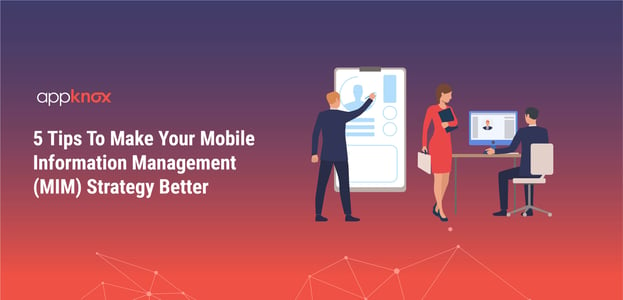
BLOG

BLOG
The Enterprise Mobility Management strategy for every organization is different. But it always include three major strategies that are Mobile Device Management (MDM), Mobile Application Management (MAM) and Mobile Information Management (MIM), since the main areas to be covered are the areas of device, app and information.
Mobile Information Management (MIM) deals with the aspects of security of all crucial information. MIM has a big role to play in keeping all your sensitive corporate data safe and secure. And the following tips can really help you in making your mobile information management strategy better and more secure.
Compatible with almost any system, MIM involves keeping all the sensitive data infrastructure secured by letting only trusted applications have access to them. The MIM strategy is based on cloud infrastructure where documents and files are synced across several devices.
Generally, MIM is differentiated from other security techniques based on the fact that it focuses more on data than applications and devices using that data. Using this system of mobile security, sensitive data is encrypted using strong passwords and hashing techniques, and its storage, transmission and access are heavily supervised.
Highly secure mobile information management solutions focus strongly on establishing clear plans of actions to enforce MIM in business enterprises. They make sure that employees are well aware of the risks and are securely accessing and using data on their mobile devices inside the organization.
A number of MIM solutions like RES Hyperdrive, Nomadesk, Microsoft SkyDrive, Dropbox, and Google Drive can be used to enforce on-premises MIM strategies across the organization.
Any MIM strategy has to start with encryption and password protection. If you forget about the mobile devices or the apps and concentrate on locking the information itself, that is what MIM actually does.
Designing your own information governance (IG) will ensure that the information that is crucial to your firm is not vulnerable to any mobile device or app.
All the IG rules must go hand in hand with the expectation of anticipating mobility in company's data assets and device users. This may also raise the need for regular updates to the existing IG rule portfolios. The IG rules must connect more closely to the data assets rather than user behaviors. This will allow that the responsive policies and controls for mobile devices, are evaluated and designed in a better manner.
The IT department must be capable of governing data not only within the company's own systems, but also when that data is mobile and moving outside the firewalls. Anticipate the mobility of data assets so as to let the enterprise govern the information fully.
Governing digital assets is a big responsibility and a set number of information governance rules can’t handle it all. It requires a lot more from the MIM strategy builders. In order to build up a successful mobile information management strategy, you must expand the scope of information governance to govern mobile data assets throughout the information lifecycle. This includes getting access to how digital assets are created, saved, accessed, modified, sent, received, stored, preserved and scheduled for disposition.
It is necessary to stick to the legal rules. Your MIM strategy must support all mandatory legal requirements including the availability of specific types of records. When building up rules and processes within your MIM strategy, you must review all applicable legal rules and incorporate any functional requirements for mobile devices so as to align to those legal rules.
Build up a MIM strategy that secures all your crucial data so that it is no more dependent on the mobile devices and apps for its protection.
Good Read: Detailed Guide on Vulnerability Management
.jpg?width=50&height=50&name=10606600_10204086667262761_7381430219125488912_n%20(1).jpg)
Hackers never rest. Neither should your security!
Stay ahead of emerging threats, vulnerabilities, and best practices in mobile app security—delivered straight to your inbox.
![]() Exclusive insights. Zero fluff. Absolute security.
Exclusive insights. Zero fluff. Absolute security.
![]() Join the Appknox Security Insider Newsletter!
Join the Appknox Security Insider Newsletter!
